formerly eScholarship Editions


|
|
|
|
Your search for
'Music' in subject
found 59 book(s). | Modify Search | Displaying 41 - 59 of 59 book(s) | |
| 41. | 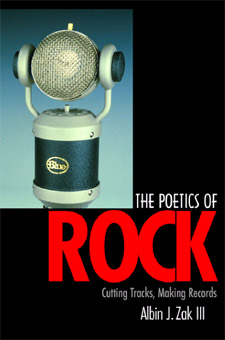 | Title: The poetics of rock: cutting tracks, making records Author: Zak, Albin Published: University of California Press, 2001 Subjects: Music | Popular Music | American Music | Musicology | Contemporary Music | American Studies | Media Studies | Popular Music Publisher's Description: After a hundred years of recording, the process of making records is still mysterious to most people who listen to them. Records hold a fundamental place in the dynamics of modern musical life, but what do they represent? Are they documents? Snapshots? Artworks? Fetishes? Commodities? Conveniences? The Poetics of Rock is a fascinating exploration of recording consciousness and compositional process from the perspective of those who make records. In it, Albin Zak examines the crucial roles played by recording technologies in the construction of rock music and shows how songwriters, musicians, engineers, and producers contribute to the creative project, and how they all leave their mark on the finished work. Zak shapes an image of the compositional milieu by exploring its elements and discussing the issues and concerns faced by artists. Using their testimony to illuminate the nature of record making and of records themselves, he shows that the art of making rock records is a collaborative compositional process that includes many skills and sensibilities not traditionally associated with musical composition. Zak connects all the topics--whether technical, conceptual, aesthetic, or historical--with specific artists and recordings and illustrates them with citations from artists and with musical examples. In lively and engaging prose, The Poetics of Rock brilliantly illustrates how the musical energy from a moment of human expression translates into a musical work wrought in sound. [brief] Similar Items |
| 42. | 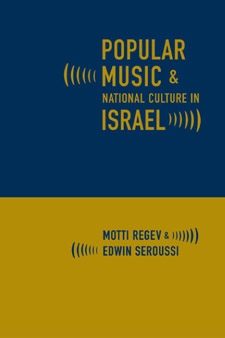 | Title: Popular music and national culture in Israel Author: Regev, Motti Published: University of California Press, 2004 Subjects: Music | Ethnomusicology | Middle Eastern Studies | Popular Culture | Jewish Studies Publisher's Description: A unique Israeli national culture - indeed, the very nature of "Israeliness" - remains a matter of debate, a struggle to blend vying memories and backgrounds, ideologies and wills. Identifying popular music as an important site in this wider cultural endeavor, this book focuses on the three major popular music cultures that are proving instrumental in attempts to invent Israeliness: the invented folk song repertoire known as Shirei Eretz Israel; the contemporary, global-cosmopolitan Israeli rock; and the ethnic-oriental musica mizrahit. The result is the first ever comprehensive study of popular music in Israel. Motti Regev, a sociologist, and Edwin Seroussi, an ethnomusicologist, approach their subject from alternative perspectives, producing a truly interdisciplinary, sociocultural account of music as a feature and a force in the shaping of Israeliness. A major ethnographic undertaking, describing and analyzing the particular history, characteristics, and practices of each music culture, Popular Music and National Culture in Israel maps not only the complex field of Israeli popular music but also Israeli culture in general. [brief] Similar Items |
| 43. | 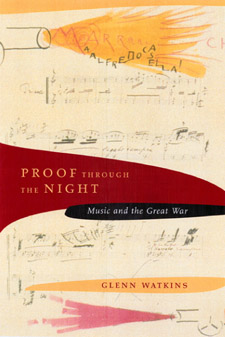 | Title: Proof through the night: music and the great war Author: Watkins, Glenn 1927- Published: University of California Press, 2002 Subjects: Music | Musicology | American Music | European History | United States History Publisher's Description: Carols floating across no-man's-land on Christmas Eve 1914; solemn choruses, marches, and popular songs responding to the call of propaganda ministries and war charities; opera, keyboard suites, ragtime, and concertos for the left hand - all provided testimony to the unique power of music to chronicle the Great War and to memorialize its battles and fallen heroes in the first post-Armistice decade. In this striking book, Glenn Watkins investigates these variable roles of music primarily from the angle of the Entente nations' perceived threat of German hegemony in matters of intellectual and artistic accomplishment - a principal concern not only for Europe but also for the United States, whose late entrance into the fray prompted a renewed interest in defining America as an emergent world power as well as a fledgling musical culture. He shows that each nation gave "proof through the night" - ringing evidence during the dark hours of the war - not only of its nationalist resolve in the singing of national airs but also of its power to recall home and hearth on distant battlefields and to reflect upon loss long after the guns had been silenced. Watkins's eloquent narrative argues that twentieth-century Modernism was not launched full force with the advent of the Great War but rather was challenged by a new set of alternatives to the prewar avant-garde. His central focus on music as a cultural marker during the First World War of necessity exposes its relationship to the other arts, national institutions, and international politics. From wartime scores by Debussy and Stravinsky to telling retrospective works by Berg, Ravel, and Britten; from "La Marseillaise" to "The Star-Spangled Banner," from "It's a Long Way to Tipperary" to "Over There," music reflected society's profoundest doubts and aspirations. By turns it challenged or supported the legitimacy of war, chronicled misgivings in miniature and grandiose formats alike, and inevitably expressed its sorrow at the final price exacted by the Great War. Proof through the Night concludes with a consideration of the post-Armistice period when, on the classical music front, memory and distance forged a musical response that was frequently more powerful than in wartime. [brief] Similar Items |
| 44. | 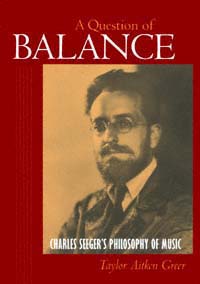 | Title: A question of balance: Charles Seeger's philosophy of music Author: Greer, Taylor Aitken 1955- Published: University of California Press, 1998 Subjects: Music | Ethnomusicology | Musicology | Composers Publisher's Description: One of this century's most influential musical intellects takes center stage in Taylor Greer's meticulously wrought study of Charles Seeger (1886-1979). Seeger left an indelible mark in the fields of musicology, music criticism, ethnomusicology, and avant-garde musical composition, but until now there has been no extended appreciation and critique of Seeger's work as a whole, nor has an accessible guide to his texts been available.Exploring the entire corpus of Charles Seeger's writing, A Question of Balance highlights the work of those persons who most influenced him, especially Henri Bergson, Bertrand Russell, and Ralph Perry. Invited to inaugurate the music department at the University of California's Berkeley campus in 1912, Seeger became keenly aware of his deficiencies in general education and put himself on a rigorous regimen of intellectual development that included studying history, anthropology, political theory, and philosophy. For the remainder of his life his ideas about music heavily influenced the development of ethnomusicology and systematic musicology.Charles Seeger is perhaps best known as the father of the folk singers Pete, Mike, and Peggy Seeger and as the husband of the innovative American composer Ruth Crawford. This book makes clear that Seeger was an extremely important thinker and educator in his own right. Seeger's intellectual curiosity was as eclectic as it was enthusiastic, and Greer skillfully weaves together the connections Seeger made between music, the humanities, and the sciences. The result is a luminous tapestry depicting Seeger's ideal schemes of musicology. At the same time it reflects the turbulence and vitality in American musical life during the early decades of the century. [brief] Similar Items |
| 45. | 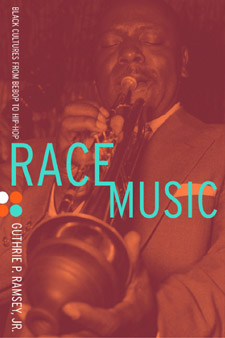 | Title: Race music: black cultures from bebop to hip-hop Author: Ramsey, Guthrie P Published: University of California Press, 2003 Subjects: Music | American Music | American Studies | Popular Music | United States History | Ethnomusicology | African American Studies Publisher's Description: This powerful book covers the vast and various terrain of African American music, from bebop to hip-hop. Guthrie P. Ramsey, Jr., begins with an absorbing account of his own musical experiences with family and friends on the South Side of Chicago, evoking Sunday-morning worship services, family gatherings with food and dancing, and jam sessions at local nightclubs. This lays the foundation for a brilliant discussion of how musical meaning emerges in the private and communal realms of lived experience and how African American music has shaped and reflected identities in the black community. Deeply informed by Ramsey's experience as an accomplished musician, a sophisticated cultural theorist, and an enthusiast brought up in the community he discusses, Race Music explores the global influence and popularity of African American music, its social relevance, and key questions regarding its interpretation and criticism. Beginning with jazz, rhythm and blues, and gospel, this book demonstrates that while each genre of music is distinct - possessing its own conventions, performance practices, and formal qualities - each is also grounded in similar techniques and conceptual frameworks identified with African American musical traditions. Ramsey provides vivid glimpses of the careers of Dinah Washington, Louis Jordan, Dizzy Gillespie, Cootie Williams, and Mahalia Jackson, among others, to show how the social changes of the 1940s elicited an Afro-modernism that inspired much of the music and culture that followed. Race Music illustrates how, by transcending the boundaries between genres, black communities bridged generational divides and passed down knowledge of musical forms and styles. It also considers how the discourse of soul music contributed to the vibrant social climate of the Black Power Era. Multilayered and masterfully written, Race Music provides a dynamic framework for rethinking the many facets of African American music and the ethnocentric energy that infused its creation. [brief] Similar Items |
| 46. | 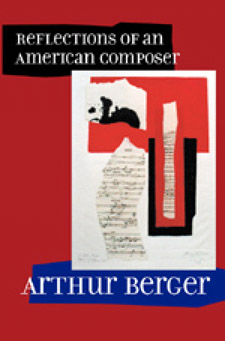 | Title: Reflections of an American composer Author: Berger, Arthur 1912- Published: University of California Press, 2002 Subjects: Music | American Music | Classical Music | Contemporary Music | Composers | Musicology Publisher's Description: In this engrossing collection of essays, distinguished composer, theorist, journalist, and educator Arthur Berger invites us into the vibrant and ever-changing American music scene that has been his home for most of the twentieth century. Witty, urbane, and always entertaining, Berger describes the music scene in New York and Boston since the 1930s, discussing the heady days when he was a member of a tight-knit circle of avant-garde young composers mentored by Aaron Copland as well as his participation in a group at Harvard University dedicated to Stravinsky. As Virgil Thomson's associate on the New York Herald Tribune and founding editor of the prestigious Perspectives of New Music, Berger became one of the preeminent observers and critics of American music. His reflections on the role of music in contemporary life, his journalism career, and how changes in academia influence the composition and teaching of music offer a unique perspective informed by Berger's abundant intelligence and experience. [brief] Similar Items |
| 47. | 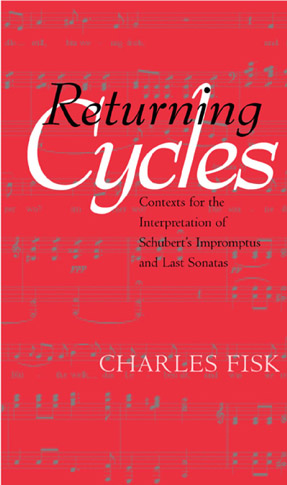 | Title: Returning cycles: contexts for the interpretation of Schubert's impromptus and last sonatas Author: Fisk, Charles Published: University of California Press, 2001 Subjects: Music | Musicology | Composers Publisher's Description: This compelling investigation of the later music of Franz Schubert explores the rich terrain of Schubert's impromptus and last piano sonatas. Drawing on the relationships between these pieces and Schubert's Winterreise song cycle, his earlier "Der Wanderer," the closely related "Unfinished" Symphony, and his story of exile and homecoming, "My Dream," Charles Fisk explains how Schubert's view of his own life may well have shaped his music in the years shortly before his death. Fisk's intimate portrayal of Schubert is based on evidence from the composer's own hand, both verbal (song texts and his written words) and musical (vocal and instrumental). Noting extraordinary aspects of tonality, structure, and gestural content, Fisk argues that through his music Schubert sought to alleviate his apparent sense of exile and his anticipation of early death. Fisk supports this view through close analyses of the cyclic connections within and between the works he explores, finding in them complex musical narratives that attempt to come to terms with mortality, alienation, hope, and desire. Fisk's knowledge of Schubert's life and music, together with his astute and imaginative attention to musical detail, helps him achieve one of the most difficult goals in music criticism: to capture and verbalize the human content of instrumental music. [brief] Similar Items |
| 48. | 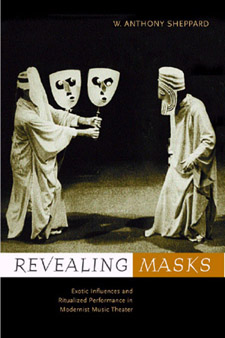 | Title: Revealing masks: exotic influences and ritualized performance in modernist music theater Author: Sheppard, William Anthony 1969- Published: University of California Press, 2001 Subjects: Music | American Music | Contemporary Music | Ethnomusicology | Opera | Musicology | Intellectual History Publisher's Description: W. Anthony Sheppard considers a wide-ranging constellation of important musical works in this fascinating exploration of ritualized performance in twentieth-century music. Revealing Masks uncovers the range of political, didactic, and aesthetic intents that inspired the creators of modernist music theater. Sheppard is especially interested in the use of the "exotic" in techniques of masking and stylization, identifying Japanese Noh, medieval Christian drama, and ancient Greek theater as the most prominent exotic models for the creation of "total theater." Drawing on an extraordinarily diverse - and in some instances, little-known - range of music theater pieces, Sheppard cites the work of Igor Stravinsky, Benjamin Britten, Arthur Honegger, Peter Maxwell Davies, Harry Partch, and Leonard Bernstein, as well as Andrew Lloyd Webber and Madonna. Artists in literature, theater, and dance - such as William Butler Yeats, Paul Claudel, Bertolt Brecht, Isadora Duncan, Ida Rubenstein, and Edward Gordon Craig--also play a significant role in this study. Sheppard poses challenging questions that will interest readers beyond those in the field of music scholarship. For example, what is the effect on the audience and the performers of depersonalizing ritual elements? Does borrowing from foreign cultures inevitably amount to a kind of predatory appropriation? Revealing Masks shows that compositional concerns and cultural themes manifested in music theater are central to the history of twentieth-century Euro-American music, drama, and dance. [brief] Similar Items |
| 49. | 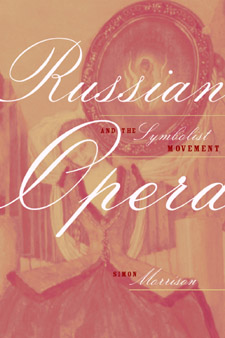 | Title: Russian opera and the symbolist movement Author: Morrison, Simon Alexander 1964- Published: University of California Press, 2002 Subjects: Music | Opera | Musicology | Composers | Russian and Eastern European Studies | Literature Publisher's Description: An aesthetic, historical, and theoretical study of four scores, Russian Opera and the Symbolist Movement is a groundbreaking and imaginative treatment of the important yet neglected topic of Russian opera in the Silver Age. Spanning the gap between the supernatural Russian music of the nineteenth century and the compositions of Prokofiev and Stravinsky, this exceptionally insightful and well-researched book explores how Russian symbolist poets interpreted opera and prompted operatic innovation. Simon Morrison shows how these works, though stylistically and technically different, reveal the extent to which the operatic representation of the miraculous can be translated into its enactment. Morrison treats these largely unstudied pieces by canonical composers: Tchaikovsky's Queen of Spades, Rimsky-Korsakov's Legend of the Invisible City of Kitezh and the Maiden Fevroniya, Scriabin's unfinished Mysterium, and Prokofiev's Fiery Angel. The chapters, revisionist studies of these composers and scores, address separate aspects of Symbolist poetics, discussing such topics as literary and musical decadence, pagan-Christian syncretism, theurgy, and life creation, or the portrayal of art in life. The appendix offers the first complete English-language translation of Scriabin's libretto for the Preparatory Act. Providing valuable insight into both the Symbolist enterprise and Russian musicology, this book casts new light on opera's evolving, ambiguous place in fin de siècle culture. [brief] Similar Items |
| 50. | 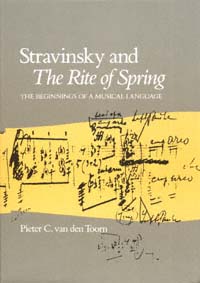 | Title: Stravinsky and the Rite of spring: the beginnings of a musical language Author: Van den Toorn, Pieter C 1938- Published: University of California Press, 1987 Subjects: Music | Composers Similar Items |
| 51. | 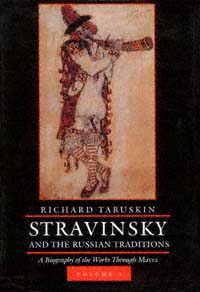 | Title: Stravinsky and the Russian traditions: a biography of the works through Mavra Author: Taruskin, Richard Published: University of California Press, 1996 Subjects: Music | Musicology | Russian and Eastern European Studies Publisher's Description: This book undoes 50 years of mythmaking about Stravinsky's life in music.During his spectacular career, Igor Stravinsky underplayed his Russian past in favor of a European cosmopolitanism. Richard Taruskin has refused to take the composer at his word. In this long-awaited study, he defines Stravinsky's relationship to the musical and artistic traditions of his native land and gives us a dramatically new picture of one of the major figures in the history of music.Taruskin draws directly on newly accessible archives and on a wealth of Russian documents. In Volume One, he sets the historical scene: the St. Petersburg musical press, the arts journals, and the writings of anthropologists, folklorists, philosophers, and poets. Volume Two addresses the masterpieces of Stravinsky's early maturity - Petrushka, The Rite of Spring, and Les Noces . Taruskin investigates the composer's collaborations with Diaghilev to illuminate the relationship between folklore and modernity. He elucidates the Silver Age ideal of "neonationalism" - the professional appropriation of motifs and style characteristics from folk art - and how Stravinsky realized this ideal in his music.Taruskin demonstrates how Stravinsky achieved his modernist technique by combining what was most characteristically Russian in his musical training with stylistic elements abstracted from Russian folklore. The stylistic synthesis thus achieved formed Stravinsky as a composer for life, whatever the aesthetic allegiances he later professed.Written with Taruskin's characteristic mixture of in-depth research and stylistic verve, this book will be mandatory reading for all those seriously interested in the life and work of Stravinsky. [brief] Similar Items |
| 52. | 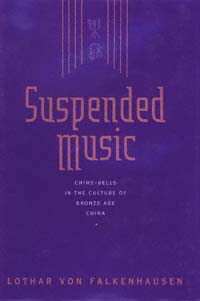 | Title: Suspended music: chime-bells in the culture of Bronze Age China Author: Falkenhausen, Lothar von Published: University of California Press, 1994 Subjects: History | Music | Asian History | China | Art History Publisher's Description: The Chinese made the world's first bronze chime-bells, which they used to perform ritual music, particularly during the Shang and Zhou dynasties (ca. 1700-221 B.C.). Lothar von Falkenhausen's rich and detailed study reconstructs how the music of these bells - the only Bronze Age instruments that can still be played - may have sounded and how it was conceptualized in theoretical terms. His analysis and discussion of the ritual, political, and technical aspects of this music provide a unique window into ancient Chinese culture.This is the first interdisciplinary perspective on recent archaeological finds that have transformed our understanding of ancient Chinese music. Of great significance to the understanding of Chinese culture in its crucial formative stage, it provides a fresh point of departure for exploring later Asian musical history and offers great possibilities for comparisons with music worldwide. [brief] Similar Items |
| 53. | 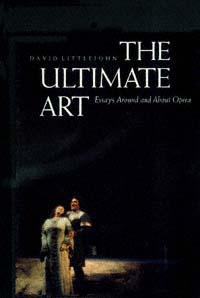 | Title: The ultimate art: essays around and about opera Author: Littlejohn, David 1937- Published: University of California Press, 1992 Subjects: Music | Opera Publisher's Description: Anyone who cares about opera will find The Ultimate Art a thoroughly engaging book. David Littlejohn's essays are exciting, provocative, sometimes even outrageous. They reflect his deep love of opera - that exotic, extravagant, and perpetually popular hybrid performing art form - and his fascination with the many worlds from which it sprang.From its seventeenth-century beginnings, opera has been decried by its detractors for its elitism, its artifice, its absurd costliness, and its social irrelevance. But Littlejohn makes us see that opera embraces an extraordinary amount of intense human emotion and experience, Western culture, and individual psychology. It is also the most complex, challenging, and demanding form of public performance ever developed - at its most spectacular it pulls together in one evening a play, a concert, a ballet, and a pageant, not to mention an exhibition of painting and sculpture. Every opera is a veritable piece of cultural history.The book begins with "The Difference Is They Sing," a potentially controversial essay on the nature of opera and its place in modern culture. From there Littlejohn goes on to consider everything from "Sex and Religion in French Opera" to "What Peter Sellars Did to Mozart." He tells us about every major staging of Wagner's Ring cycle since 1876, the troubled fate (in legend, history, and opera) of the city of Nuremberg, and the volatile collaboration of Richard Strauss and Hugo von Hofmannsthal.Littlejohn presents these and many other fascinating moments in the history of opera with conviction and flair. By the end of the book the reader may very well be persuaded that opera is indeed the ultimate art. [brief] Similar Items |
| 54. | 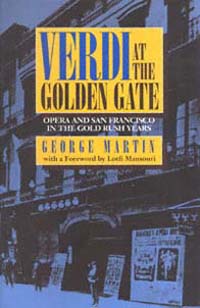 | Title: Verdi at the Golden Gate: opera and San Francisco in the Gold Rush years Author: Martin, George Whitney Published: University of California Press, 1993 Subjects: Music | History | Opera | Composers | American Studies | California and the West | European History Publisher's Description: Opera is a fragile, complex art, but it flourished extravagantly in San Francisco during the Gold Rush years, a time when daily life in the city was filled with gambling, duels, murder, and suicide. In the history of the United States there has never been a rougher town than Gold Rush San Francisco, yet there has never been a greater frenzy for opera than developed there in these exciting years.How did this madness for opera take root and grow? Why did the audience's generally drunken, brawling behavior gradually improve? How and why did Verdi emerge as the city's favorite composer? These are the intriguing themes of George Martin's enlightening and wonderfully entertaining story. Among the incidents recounted are the fist fight that stopped an opera performance and ended in a fatal duel; and the brothel madam who, by sitting in the wrong row of a theater, caused a fracas that resulted in the formation of the Vigilantes of 1856.Martin weaves together meticulously gathered social, political, and musical facts to create this lively cultural history. His study contributes to a new understanding of urban culture in the Jacksonian?Manifest Destiny eras, and of the role of opera in cities during this time, especially in the American West. Over it all soars Verdi's somber, romantic music, capturing the melancholy, the feverish joy, and the idealism of his listeners. [brief] Similar Items |
| 55. | 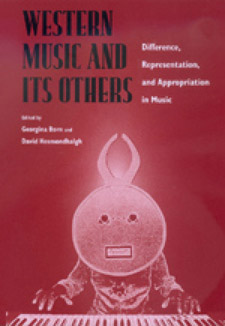 | Title: Western music and its others: difference, representation, and appropriation in music Author: Born, Georgina Published: University of California Press, 2000 Subjects: Music | Ethnomusicology | Cultural Anthropology | Sociology | Postcolonial Studies | Popular Culture Publisher's Description: This innovative collection of articles offers a major comprehensive overview of new developments in cultural theory as applied to Western music. Addressing a broad range of primarily twentieth-century music, the authors examine two related phenomena: musical borrowings or appropriations, and how music has been used to construct, evoke, or represent difference of a musical or a sociocultural kind. The essays scrutinize a diverse body of music and discuss a range of significant examples, among them musical modernism's idealizing or ambivalent relations with popular, ethnic, and non-Western music; exoticism and orientalism in the experimental music tradition; the representation of others in Hollywood film music; music's role in the formation and contestation of collective identities, with reference to Jewish and Turkish popular music; and issues of representation and difference in jazz, world music, hip hop, and electronic dance music. Written by leading scholars from disciplines including historical musicology, sociology, ethnomusicology, anthropology, popular music studies, and film studies, the essays provide unprecedented insights into how cultural identities and differences are constructed in music. [brief] Similar Items |
| 56. | 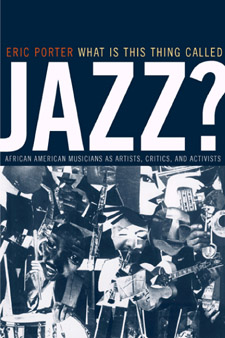 | Title: What is this thing called jazz?: African American musicians as artists, critics, and activists Author: Porter, Eric (Eric C.) Published: University of California Press, 2002 Subjects: Music | History | United States History | American Studies | African American Studies | American Music | Contemporary Music | Jazz Publisher's Description: Despite the plethora of writing about jazz, little attention has been paid to what musicians themselves wrote and said about their practice. An implicit division of labor has emerged where, for the most part, black artists invent and play music while white writers provide the commentary. Eric Porter overturns this tendency in his creative intellectual history of African American musicians. He foregrounds the often-ignored ideas of these artists, analyzing them in the context of meanings circulating around jazz, as well as in relationship to broader currents in African American thought. Porter examines several crucial moments in the history of jazz: the formative years of the 1920s and 1930s; the emergence of bebop; the political and experimental projects of the 1950s, 1960s and 1970s; and the debates surrounding Jazz at Lincoln Center under the direction of Wynton Marsalis. Louis Armstrong, Anthony Braxton, Marion Brown, Duke Ellington, W.C. Handy, Yusef Lateef, Abbey Lincoln, Charles Mingus, Archie Shepp, Wadada Leo Smith, Mary Lou Williams, and Reggie Workman also feature prominently in this book. The wealth of information Porter uncovers shows how these musicians have expressed themselves in print; actively shaped the institutional structures through which the music is created, distributed, and consumed, and how they aligned themselves with other artists and activists, and how they were influenced by forces of class and gender. What Is This Thing Called Jazz? challenges interpretive orthodoxies by showing how much black jazz musicians have struggled against both the racism of the dominant culture and the prescriptive definitions of racial authenticity propagated by the music's supporters, both white and black. [brief] Similar Items |
| 57. | 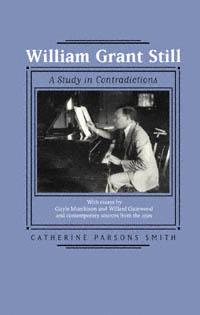 | Title: William Grant Still: a study in contradictions Author: Smith, Catherine Parsons 1933- Published: University of California Press, 2000 Subjects: Music | Composers | African American Studies | Autobiographies and Biographies Publisher's Description: During the 1930s and 1940s William Grant Still (1895-1978) was known as the "Dean of Afro-American Composers." He worked as an arranger for early radio, on Broadway, and in Hollywood; major symphony orchestras performed his concert works; and an opera, written in collaboration with Langston Hughes, was produced by the New York City Opera. Despite these successes the composer's name gradually faded into obscurity. This book brings William Grant Still out of the archives and examines his place in America's musical heritage. It also provides a revealing window into our recent cultural past.Until now Still's profound musical creativity and cultural awareness have been obscured by the controversies that dogged much of his personal and professional life. New topics explored by Catherine Parsons Smith and her contributors include the genesis of the Afro American Symphony , Still's best-known work; his troubled years in film and opera; and his outspoken anticommunism. [brief] Similar Items |
| 58. | 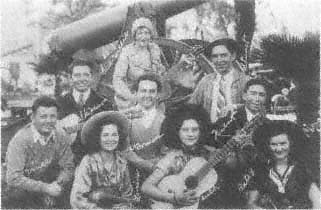 | Title: Workin' man blues: country music in California Author: Haslam, Gerald W Published: University of California Press, 1999 Subjects: Music | American Music | California and the West Publisher's Description: California has been fertile ground for country music since the 1920s, nurturing a multitude of talents from Gene Autry to Glen Campbell, Rose Maddox to Barbara Mandrell, Buck Owens to Merle Haggard. In this affectionate homage to California's place in country music's history, Gerald Haslam surveys the Golden State's contributions to what is today the most popular music in America. At the same time he illuminates the lives of the white, working-class men and women who migrated to California from the Dust Bowl, the Hoovervilles, and all the other locales where they had been turned out, shut down, or otherwise told to move on.Haslam's roots go back to Oildale, in California's central valley, where he first discovered the passion for country music that infuses Workin' Man Blues . As he traces the Hollywood singing cowboys, Bakersfield honky-tonks, western-swing dance halls, "hillbilly" radio shows, and crossover styles from blues and folk music that also have California roots, he shows how country music offered a kind of cultural comfort to its listeners, whether they were oil field roustabouts or hash slingers.Haslam analyzes the effects on country music of population shifts, wartime prosperity, the changes in gender roles, music industry economics, and television. He also challenges the assumption that Nashville has always been country music's hometown and Grand Ole Opry its principal venue. The soul of traditional country remains romantically rural, southern, and white, he says, but it is also the anthem of the underdog, which may explain why California plays so vital a part in its heritage: California is where people reinvent themselves, just as country music has reinvented itself since the first Dust Bowl migrants arrived, bringing their songs and heartaches with them. [brief] Similar Items |
| 59. |  | Title: Writing about music: a style sheet from the editors of 19th-century music Author: Holoman, D. Kern 1947- Published: University of California Press, 1988 Subjects: Music | Music Publisher's Description: How do you spell Rachmaninov?Where do you place the hyphen in Hofmannsthal if it breaks across two lines? Is it premiere or première? The answers and much more can be found in a new, essential resource for authors, students, editors, concert producers - anyone who deals with music in print. An expanded version of the style sheet for the well-known journal 19th-Century Music , this small volume covers some of the thorniest issues of musical discourse: how to go about describing musical works and procedures in prose, the rules for citations in notes and bibliography, and proper preparation of such materials as musical examples, tables, and illustrations. One section discusses program notes, another explains the requirements of submitting manuscripts written on a word processor. An appendix lists common problem words. [brief] Similar Items |